AGRONOMIC UPDATE – JUNE 18, 2022….As always, Mother Nature in control….
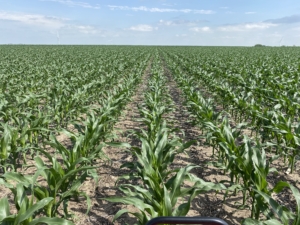
Nice looking field of P0339Q….June, 13, 2022
So far in 2022, Mother Nature has let us know that she is still in control! We have experienced just about the whole range of weather conditions since planting began….drought & wet, hot & cold, frost, hail, wind & Derecho….while this is nothing new to our area, it has been sometime since we’ve seen all of these weather conditions show up in such a small time frame and at such extremes.
TOPICS FOR THIS UPDATE:
- Planting and Early Spring conditions….
- Temperatures & GDU accumulation
- What’s going on in my fields right now….
- Crop Water Use
- Rapid Growth Syndrome in Corn
- Insect Update
- Granular Insights
PLANTING AND EARLY SPRING CONDITIONS…..
So far there are three words that have had the greatest impact on planting conditions, crop emergence and potential impact on final yields, and they would be….RESIDUE, RESIDUE & RESIDUE….with wind, and dry, hard soils also playing a role.
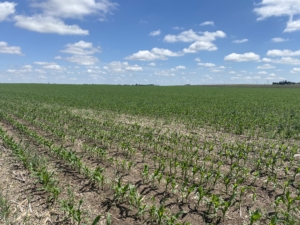
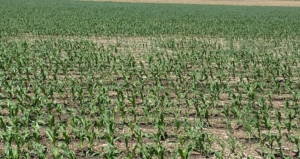
These two photos show some of the impact from the residue and the windy conditions we experienced this spring, especially the Derecho in May. Crop residue was at the top of the list for issues one had to face both during and after planting this year….no field was spared this issue.
Along with the wind and residue, we also experienced two cold spells during the planting season which impacted overall soybean emergence and final plant stands. It seemed like it took 3 weeks or so for soybeans to emerge regardless of planting date. The first cold spell was April 30-May 6 with soil temps falling to 46 degrees during that time. The second cold spell was from May 20-25 with soil temps falling to the low-50’s….this was also the same time period we had the frost. All of this impacted soybeans by slowing down overall emergence and allowing increased time for pests to attack the seed….ex. seedcorn maggots in the tilled, sandy fields. This was compounded if planting depth was on the deep side. As the two photos below show….
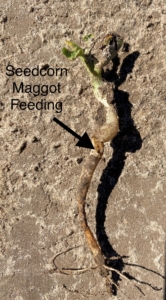
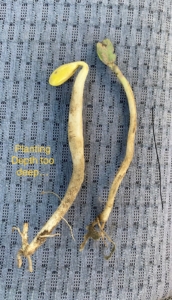
Some management tips to keep in mind for next year:
- If planting early (April), keep populations on the upper end….another 20,000 would’ve went along way to eliminating replant.
- Consider treating with the new insecticide Lumiderm from Pioneer. This will give increased control of seedcorn maggots and other seed-attacking pests….especially in tilled and sandier soils.
- Keep planting depths at under 2″ maximum. Too deep of planting depth delays emergence which allows the bean to be affected by cold temps and pests.
TEMPERATURES & GDU ACCUMULATION:
As of June 17, we have accumulated approximately the following for Growing Degree Units in 2022:
Planting Date GDD’s2022 Average GDD Departure from average
April 21 777 776 even
April 28 711 726 -15 (-1 day)
May 9 648 632 +16 (1 days)
As you can see from the above numbers, we are basically even on GDD accumulation for the year, which puts us slightly behind 2021 at present. We have been warmer than normal for the past week and the forecast keeps us that way.
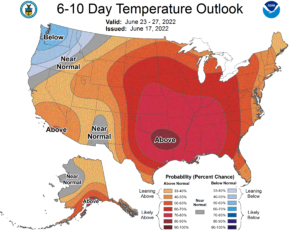
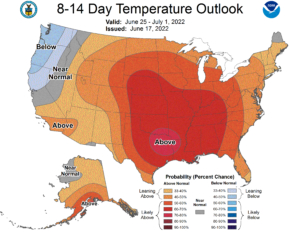
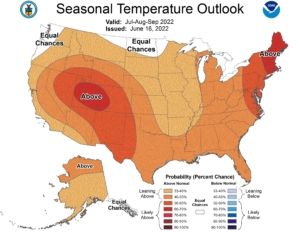
The above temperature maps are the 6-10 day, 8-14 day and 3 month seasonal outlooks. The maps are predicting a warm summer, much like last year.
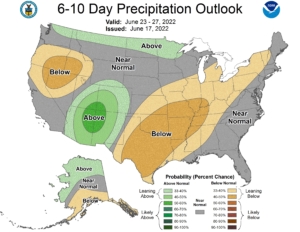
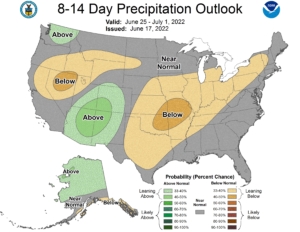
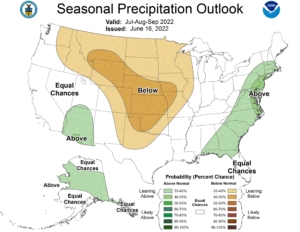
The above precipitation maps are the 6-10 day, 8-14 day and 3 month seasonal outlooks. Next two weeks are trending drier than normal and then the rest of the summer is predicted to be that way….again, much like last year. And if you recall during April and May, the predicition’s
WHAT’S GOING ON IN MY FIELDS RIGHT NOW?...
Other than the areas of heavy residue, much of the corn crop looks good with very good stands overall. The majority of the April planted crop is in the 7-9 leaf stage-of-growth and the May planting dates are 5-6 leaf. From V1-V10, corn gains a leaf collar about every 83 GDU’s…this will be about every 3 – 3.5 days with current forecasted conditions. This would put us in the mid-July time frame potentially, for tasseling.
- At V5, leaf and ear shoot initiation will be complete and a microscopically small tassel is initiated in the stem apex tip, or top of the growing point. This is currently under or at the soil surface.
- At V6, the growing point and tassel will be above the soil surface and the stalk is beginning a period of greatly increased elongation.
- Determination of potential kernel rows around will be completed around V7 (range of V5-V8)…we are at the beginning, or at the end, of this stage depending upon planting date.
- The corn root system is now rapidly transitioning to the main nodal root system. When hot temperatures occur following a cool spell, crop growth at this stage can be uneven. Areas of heavy crop residue over the row will be slower due to cooler soil temps yet, which we are unfortunately seeing in abundance this year. It will take a little time for that to catch up….most likely will not catch up fully in the heavy residue areas.
- At V9, an ear shoot will develop from every above-ground node, except the las six to eight nodes below the tassel. Growth of most of the lower stalk ear shoots eventually slows, and only the upper one or two ear shoots will develop into a harvestable ear.
- At V10, the time between the appearance of new leaf stages will shorten….generally every 2-3 days.
- We are now heading into the rapid growth and accumulation of dry matter by the plant. The window for brittle snap will start to grow exponentially over the next few weeks.
- Watch temperatures as you are spraying post-herbicides on corn or beans over the next several days. When temps are in the 90’s and humidity is low, the potential for crop response from post-application of herbicides will increase. It is not recommended to be spraying during the heat of the day if temps are in the mid-upper 90’s…both for potential crop response and herbicide control.
CROP WATER USE
CROP STAGE OF GROWTH & ROOTING DEPTH:
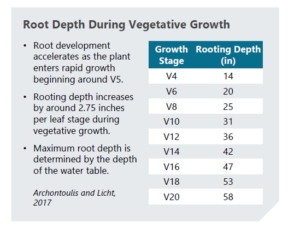 From the chart, you can see that average rooting depth for V6-V8 corn is approximately 20-25″, depending upon weather conditions, soil type and structure, etc. The AquaSpy moisture probes are showing 12-24″ rooting depths across soil types and planting dates, so we are very much in the normal on rooting depth. The video below presents where we are at on depth and crop water use.
From the chart, you can see that average rooting depth for V6-V8 corn is approximately 20-25″, depending upon weather conditions, soil type and structure, etc. The AquaSpy moisture probes are showing 12-24″ rooting depths across soil types and planting dates, so we are very much in the normal on rooting depth. The video below presents where we are at on depth and crop water use.
Video: AquaSpy Soil Moisture Update…
ET USAGE:
ET, or evapotranspiration, has been exceedingly high over the past week. Total ET from June 12-17 was 2.17 inches for our area, average of .31in/day. June 13 & 14 saw ET’s over .42in/day…we would expect to see the same the upcoming Sunday/Monday. Relative humidity over the past week has also been below normal with the increased temperatures, which increases overall ET rates. This trend in above normal ET rates will continue over the next two weeks under the above forecasts. The two charts below show ET rates for vegetative and reproductive stages for corn. The chart on the right breaks down ET rates for weather conditions. Note the increase under hot/dry conditions.
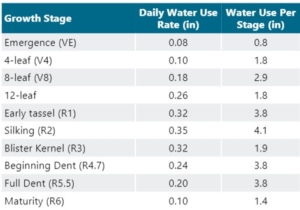
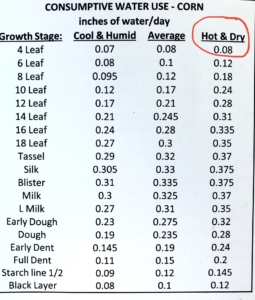
Things to keep in mind over the next weeks on irrigation management:
- Good idea to check to make sure your pivots are applying what the timer says it is. Being short .20-.30″ each circle adds up to a lot over the irrigation season. You want to catch this early…..
- Keep in mind control hours on electric pivots, you may want to change control hours as the year progresses.
- Be prepared for wells to lose pressure over time in heavy irrigation periods. May want to check on acid supplies for acidizing wells later in the year.
- Check satellite imagery often starting now and through August to catch any sprinkler issues or water patterns in time for them to be corrected.
- In those areas that were hailed, check your sprinklers, many may need replacing….
- Always keep safety in the forefront as you irrigate….take your time when around power boxes, motors, etc.
RAPID GROWTH SYNDROME IN CORN
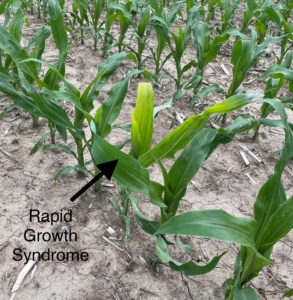
Rapid growth syndrome usually occurs when corn leaves fail to unfurl properly and the whorl becomes tightly wrapped and twisted. It is generally associated with an abrupt transition from cool temperature to warmer conditions, which we are now experiencing. This syndrome usually occurs in the late V5 to early V6 stage, but can occur through and beyond V8-V9. Hybrids can also vary in there susceptibility to this. Photo June 12, 2022
The Good News: Yield doesn’t seem to be affected by the twisted growth. Once the plant is chest high the only evidence that remains is the leaves can have a crinkled appearance….this is also the yellow leaf phenomenon.
Crop Focus: Rapid Growth
INSECT UPDATE:
Corn Rootworms –
It’s about that time to start seeing our annual rootworm hatch. When we see the cotton start to fly, or the famous lightning bugs, we will know rootworm hatch is underway because it takes about the same GDU’s (680-750 soil based degree days) for all of these things to happen.
Some fun facts:
- Larvae in sandy soils can become scratched and lacerated causing more mortality
- Flooded or saturated soils will cause more mortality
- Dry soil in late summer creates deep cracks for adult egg laying for better winter survival…which we had in 2020.
- CRW will go through 3 growth stages (Each last 7-10 days)
- 3rd Instar will create the most damage to corn roots
- Begin scouting continuous corn acres mid-to-end of next week and throughout the month of June.
There are many management practices that can help mitigate the risk of yield loss or lodging due to corn rootworm. The best recommended strategy is to rotate to soybeans. Our expectations, considering the mild, dry winter we had, is for high numbers of rootworm larvae to be present this year.
Corn Rootworm: Scouting & Management Practices
GRANULAR INSIGHTS
Granular Insights imagery is now ‘live’ and running with a new image showing up every 1-3 days. This imagery is an excellent scouting tool as well as diagnostic tool. Many growers already qualify for this imagery. Please contact us to get you set up on using this new tool from Pioneer and Granular.
Granular Insights Imagery and Remote Sensing: Click Here
Please contact us for any questions or concerns you may have! Thank you for your business!!
Starman Seed Service, Inc.

